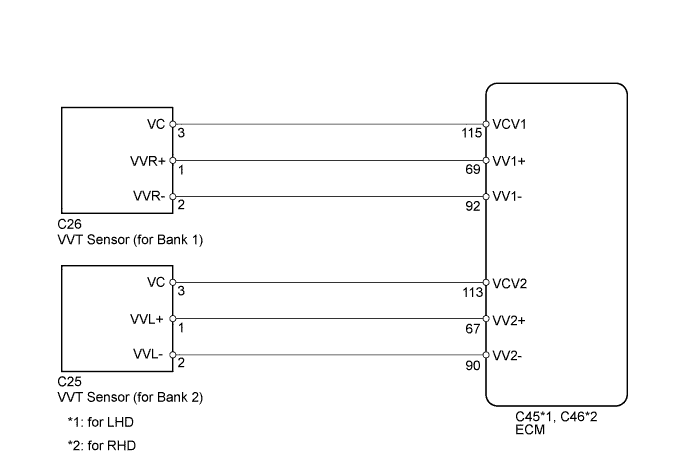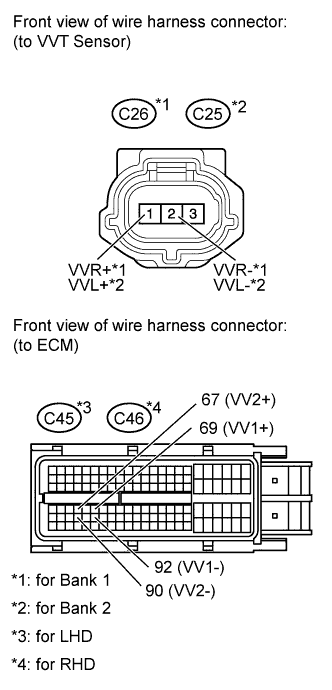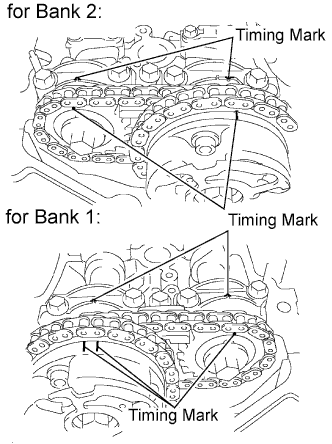CHECK VVT SENSOR (SENSOR POWER SOURCE)
CHECK HARNESS AND CONNECTOR (VVT SENSOR - ECM)
CHECK CAMSHAFT TIMING GEAR ASSEMBLY (TEETH OF PLATE)
CHECK WHETHER DTC OUTPUT RECURS
DTC P0340 Camshaft Position Sensor Circuit Malfunction
DTC P0342 Camshaft Position Sensor "A" Circuit Low Input (Bank 1 or Single Sensor)
DTC P0343 Camshaft Position Sensor "A" Circuit High Input (Bank 1 or Single Sensor)
DTC P0345 Camshaft Position Sensor "A" Circuit (Bank 2)
DTC P0347 Camshaft Position Sensor "A" Circuit Low Input (Bank 2)
DTC P0348 Camshaft Position Sensor "A" Circuit High Input (Bank 2)
Description DTC P0340 P0342 P0343 P0345 P0347 P0348
The Variable Valve Timing (VVT) sensor (VV1, 2 signal) of the intake camshaft consists of a magnet and MRE (Magnetic Resistance Element).
The VVT camshaft drive gear has a sensor plate with 3 teeth on its outer circumference. When the gear rotates, changes occur in the air gaps between the sensor plate and MRE, which affects the magnetic field. As a result, the resistance of the MRE material fluctuates. The VVT sensor converts the gear rotation data to pulse signals, uses the pulse signals to determine the camshaft angle, and sends it to the ECM.
The crankshaft angle sensor plate has 34 teeth. The pickup coil generates 34 signals for each revolution. Based on a combination of the VVT signal and NE signal, the ECM detects the crankshaft angle. Then the ECM uses this data to control fuel injection time and injection timing. Also, based on the NE signal, the ECM detects the engine speed.
| DTC Code | DTC Detection Condition | Trouble Area |
| P0340 P0345 | When either condition below is met:
|
|
| P0342 P0347 | The output voltage of the VVT sensor is below 0.3 V for 4 seconds (1 trip detection logic). | |
| P0343 P0348 | The output voltage of the VVT sensor is higher than 4.7 V for 4 seconds (1 trip detection logic). |
 Reference: Inspection using an oscilloscope
Reference: Inspection using an oscilloscope
HINT:
- The correct waveform is as shown.
- VV1+ and VV2+ stand for the VVT sensor signal, and NE+ stands for the CKP sensor signal.
Item Content Terminal NE+ - NE- VV1+ - VV1- VV2+ - VV2- Equipment Setting 5 V/DIV. 20 msec./DIV. Condition Cranking or idling
Monitor description
If no signal is transmitted by the VVT sensor despite the engine running, or the rotations of the camshaft and the crankshaft are not synchronized, the ECM interprets this as a malfunction of the sensor.
Wiring diagram

Inspection procedure
HINT:
Read freeze frame data using the intelligent tester. Freeze frame data records the engine condition when malfunctions are detected. When troubleshooting, freeze frame data can help determine if the vehicle was moving or stationary, if the engine was warmed up or not, if the air fuel ratio was lean or rich, and other data from the time the malfunction occurred.
| 1.CHECK VVT SENSOR (SENSOR POWER SOURCE) |

-
Disconnect the VVT sensor connector.
-
Measure the voltage according to the value(s) in the table below.
Standard Voltage:
Tester Connection Condition Specified Condition C25-3 (VC) - Body ground Always 4.5 to 5.0 V C26-3 (VC) - Body ground Always 4.5 to 5.0 V
|
|
||||
| OK | |
| 2.CHECK HARNESS AND CONNECTOR (VVT SENSOR - ECM) |

-
Disconnect the VVT sensor connector.
-
Disconnect the ECM connector.
-
Measure the resistance according to the value(s) in the table below.
Standard Resistance (Check for Open):
for LHD Tester Connection Condition Specified Condition C26-1 (VVR+) - C45-69 (VV1+) Always Below 1 ? C26-2 (VVR-) - C45-92 (VV1-) Always Below 1 ? C25-1 (VVL+) - C45-67 (VV2+) Always Below 1 ? C25-2 (VVL-) - C45-90 (VV2-) Always Below 1 ? for RHD Tester Connection Condition Specified Condition C26-1 (VVR+) - C46-69 (VV1+) Always Below 1 ? C26-2 (VVR-) - C46-92 (VV1-) Always Below 1 ? C25-1 (VVL+) - C46-67 (VV2+) Always Below 1 ? C25-2 (VVL-) - C46-90 (VV2-) Always Below 1 ? Standard Resistance (Check for Short):
for LHD Tester Connection Condition Specified Condition C26-1 (VVR+) or C45-69 (VV1+) - Body ground Always 10 k? or higher C26-2 (VVR-) or C45-92 (VV1-) - Body ground Always 10 k? or higher C25-1 (VVL+) or C45-67 (VV2+) - Body ground Always 10 k? or higher C25-2 (VVL-) or C45-90 (VV2-) - Body ground Always 10 k? or higher for RHD Tester Connection Condition Specified Condition C26-1 (VVR+) or C46-69 (VV1+) - Body ground Always 10 k? or higher C26-2 (VVR-) or C46-92 (VV1-) - Body ground Always 10 k? or higher C25-1 (VVL+) or C46-67 (VV2+) - Body ground Always 10 k? or higher C25-2 (VVL-) or C46-90 (VV2-) - Body ground Always 10 k? or higher
|
|
||||
| OK | |
| 3.CHECK SENSOR INSTALLATION |

-
Check the VVT sensor installation.
OK:
Sensor is installed correctly.
|
|
||||
| OK | |
| 4.CHECK VALVE TIMING |

-
Remove the cylinder head cover.
-
Turn the crankshaft pulley, and align its groove with the timing mark "0" of the timing chain cover.
-
Check that the timing marks of the camshaft timing gears are aligned with the timing marks of the bearing cap as shown in the illustration.
If not, turn the crankshaft 1 revolution (360°), then align the marks as above.
OK:
Timing marks on camshaft timing gears are aligned as shown in the illustration.
|
|
||||
| OK | |
| 5.CHECK CAMSHAFT TIMING GEAR ASSEMBLY (TEETH OF PLATE) |
-
Check the teeth of the signal plate.
OK:
Sensor plate teeth do not have any cracks or deformation.
|
|
||||
| OK | |
| 6.REPLACE VVT SENSOR |
-
Replace the VVT sensor .
| NEXT | |
| 7.CHECK WHETHER DTC OUTPUT RECURS |
-
Connect the intelligent tester to the DLC3.
-
Turn the ignition switch to ON.
-
Turn the tester on.
-
Clear the DTCs .
-
Start the engine.
-
Enter the following menus: Powertrain / Engine and ECT / DTC.
-
Read the DTCs.
Result Result Proceed to No output A P0340, P0342, P0343, P0345, P0347 or P0348 B HINT:
If the engine does not start, replace the ECM.
|
|
||||
| A | |
|